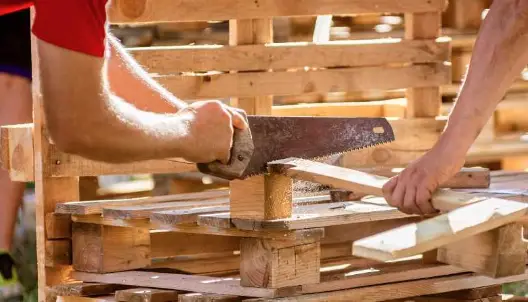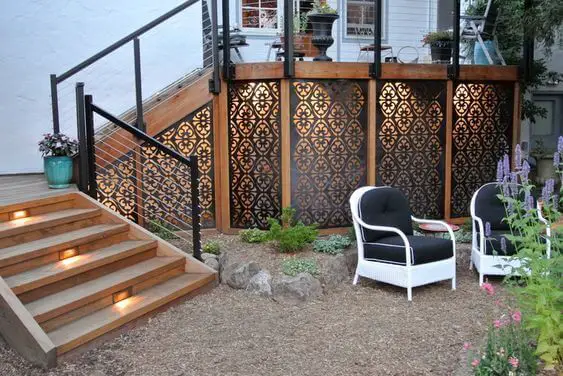Tired of dull and uninspiring fences that make your garden feel like it’s stuck in snooze mode?
It’s time to break free from the conventional and embrace the enchanting world of pallet power!
Imagine transforming discarded pallets into a jaw-dropping fence that will leave your neighbors speechless and your backyard brimming with rustic charm.
Get ready to unleash your inner DIY genius as we guide you through the whimsical journey of building a pallet fence that’s both eco-friendly and full of personality.
Contents
Step 1 – Gathering Your Pallet Arsenal
To start your pallet fence project, you’ll need to find pallets that are in good condition and suitable for repurposing.
Look for places like local warehouses, construction sites, or even online platforms where people give away pallets for free. Remember to ask for permission before taking any pallets.
When selecting pallets, opt for those made from sturdy materials, such as hardwood or pressure-treated lumber.
Inspect each pallet for damage, ensuring they are free from rot, splinters, or loose boards. It’s essential to choose pallets that are similar in size to maintain a consistent look for your fence.
Step 2 – Planning Your Fence Design
Before diving into construction, take some time to plan your fence design –
- Consider the purpose of your fence, whether it’s for privacy, keeping pets in, or simply enhancing the aesthetics of your garden.
- Pallet fences can take on various styles, from a classic picket fence to a rustic, weathered look.
- Measure the area where you intend to install the fence and calculate the number of pallets you’ll need accordingly.
- Sketch out a rough diagram of your fence, noting the height, width, and any additional features like a gate or planter box.
- This planning phase will help you visualize the final result and guide you through the construction process.
Step 3 – Building Your Pallet Fence

(i) Preparing the Pallets
Start by cleaning the pallets thoroughly to remove any dirt or debris.
Use a brush or pressure washer to ensure they are clean and ready for transformation.
Allow the pallets to dry completely before moving on to the next step.
(ii) Dismantling the Pallets
Carefully dismantle the pallets, removing all nails or screws that hold the boards together.
You can use a hammer, pry bar, or a reciprocating saw to separate the boards from the pallet frame.
Take your time to avoid splitting or damaging the wood.
(iii) Assembling the Fence
Begin by setting your fence posts or sturdy wooden stakes at regular intervals, considering the desired spacing between pallet sections.
Attach the pallet boards horizontally to the posts, aligning them evenly and ensuring they are secure.
Use screws or nails to fix the boards in place, making sure they are flush with the top and bottom rails.
For added stability, attach additional horizontal boards or crosspieces between the pallet sections.
This reinforcement will prevent the fence from sagging over time.
Be creative and experiment with different arrangements of the pallet boards to achieve your desired aesthetic.
Step 4 – Adding the Finishing Touches
Once your pallet fence is assembled, it’s time to add the finishing touches that will make it stand out –
- Sand the surface of the fence to remove any rough edges or splinters, giving it a smooth and polished look.
- Apply a protective finish or paint to enhance the durability of the wood and to match your personal style.
- To create a gate, use hinges and latch hardware to attach a pallet section that swings open and closed.
- This will provide easy access to your garden while maintaining the cohesive pallet aesthetic.
- Consider attaching planter boxes to the fence as well, creating a beautiful vertical garden that adds color and charm.
DIY Pallet Fence Ideas
When it comes to building a fence with pallets, the possibilities are endless.
With a bit of creativity and some basic DIY skills, you can transform ordinary pallets into charming and functional garden fences.
1. Picket Fence Charm
If you’re aiming for a classic look, consider building a picket fence using pallets.
- Simply dismantle the pallets to obtain the individual slats and arrange them vertically, spaced a few inches apart.
- Attach them to horizontal pallet boards for stability, and you’ll have a charming white picket fence that exudes timeless appeal.
2. Privacy Fence Oasis
If privacy is your primary concern, a pallet privacy fence can be an excellent solution.
- Stack the pallets vertically, one on top of another, ensuring that they align properly.
- This method provides a solid barrier and helps to keep prying eyes at bay while creating a cozy and secluded atmosphere in your garden.
3. Garden Planter Fence
Combine the functionality of a fence with the beauty of a planter by integrating planters into your pallet fence design.
- Attach small planter boxes to the pallets at regular intervals, allowing you to cultivate flowers, herbs, or even small vegetables right alongside your fence.
- This idea not only adds a touch of greenery but also maximizes your gardening space.
4. Multi-Level Pallet Fence
For an eye-catching and dynamic fence design, try stacking pallets at different heights.
- This creates an interesting visual effect and adds depth to your outdoor area.
- By arranging the pallets in a staggered manner, you can achieve a unique and artistic look that stands out from the traditional fence designs.
5. Pallet and Metal Combo
If you prefer a more industrial aesthetic, consider combining pallets with metal elements.
- Attach metal fence panels or gates to the pallets, creating a fusion of rustic wood and sleek metal.
- This blend of materials adds a contemporary twist to the traditional pallet fence and gives your outdoor space a modern and edgy vibe.
With a little ingenuity and some simple steps, you can transform ordinary pallets into a unique, functional, and budget-friendly fence that suits your style and fencing needs.
DIY Fence Building Vs Hiring A Professional
While building a pallet fence can be a cost-effective and creative solution for your garden, it’s essential to consider the advantages of hiring a professional fence repair company.
- DIY projects require time, effort, and expertise to ensure a sturdy and durable fence.
- In contrast, a fence repair company brings specialized knowledge, experience, and the necessary tools to get the job done efficiently.
- They can also provide valuable advice on fence design, materials, and maintenance.
Ultimately, choosing between DIY and a fence repair company depends on your skills, available time, and the desired outcome for your fence.
FAQs On How To Make A Fence Out Of Pallets

1. Can you use wood pallets to make a fence?
Yes, wooden pallet fences can be repurposed to create a fence.
By utilizing pallets, you can achieve a rustic and cost-effective fencing option that adds character to your outdoor space.
It’s important to select sturdy pallets in good condition for better durability and structural integrity.
2. How do you stabilize a pallet fence?
To stabilize a pallet fence, you can install posts at regular intervals along the fence line. Dig holes for the posts, ensuring they are deep enough for stability, and secure them using concrete.
Attach the pallets to the posts by screwing or nailing them securely. This will provide additional support and prevent the fence from wobbling.
3. How do you attach wood pallets together?
To attach wood pallets together, use screws or nails as fasteners.
Align the pallets in the desired configuration and apply even pressure while driving the fasteners through the overlapping areas of the pallets.
This will ensure a secure and stable connection between the pallets.
4. What is the cheapest fence to build?
A pallet fence is often considered one of the cheapest fences to build. Since pallets can often be obtained for free or at a low cost, utilizing them as the primary building material significantly reduces expenses.
Additionally, a pallet fence eliminates the need for purchasing separate slats or panels, further reducing costs.
5. How long will a pallet fence last?
The lifespan of a pallet fence can vary depending on factors such as the quality of the pallets, weather conditions, and maintenance.
With proper care and regular inspections, a well-built pallet fence can last for several years. However, it is important to note that pallet wood is generally not as durable as traditional fencing materials.
6. Will a pallet fence rot?
Pallet wood is susceptible to rot when exposed to moisture and weather conditions.
- To mitigate rot, apply a protective coating or sealant to the pallets.
- Regularly inspect the fence for signs of rot or decay, and promptly replace any damaged pallets to maintain the structural integrity and longevity of the fence.
Start Building A Pallet Garden Fence Today!
Building a fence out of pallets is not only a sustainable and cost-effective choice but also an opportunity to showcase your creativity and craftsmanship.
With the right materials, a well-thought-out design, and a little elbow grease, you can transform ordinary pallets into stunning fence that adds charm and functionality to your outdoor space.
Embrace the rustic allure of pallet power and embark on this DIY adventure to create a unique and eye-catching fence that will impress all who see it.



